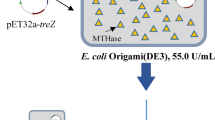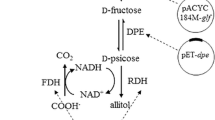Abstract
Glucuronic acid is an important biochemical with wide applications in the food and medical industries. The myo-inositol oxygenase (MIOX) gene was synthesized and expressed in Escherichia coli BL 21(DE3). After optimization of induction conditions and the culture temperature, the highest MIOX activity (45.46 kU/L) was achieved when 0.1 mM isopropyl-thio-β-d-galactoside (IPTG) was added to cell cultures with an OD600 value 1.0 followed by induction at 26°C for 8 hours. The purified MIOX enzyme exerted characteristics similar to the native form. Conversion of myo-inositol to glucuronic acid was performed using whole cells in a pH 8.5 buffer system. Whole cells harboring myo-inositol oxygenase were used as a biocatalyst to produce 2.13 g/L of glucuronic acid with a conversion rate of 99%. A promising novel process for glucuronic acid production from abundant agricultural byproducts is presented.
Similar content being viewed by others
References
Bolees H. Ausblicke in eine zukünftige Säuglingsernährung. Monatsschr. Kinderheilkd. 151: 89–96 (2003)
Mikko HMD, Pirkko AMA, Kalle HMD. Inositol supplementation in respiratory distress syndrome relationship between serum concentration, renal excretion, and lung efuent phospholipids. J. Pediatr. 110: 604–610 (1987)
Jiang WD, Wu P, Kuang SY. Myo-inositol prevents copper-induced oxidative damage and charges in antioxidant capacity in various organs and the enterocytes of juvenile Jian carp (Cyprinus carpio var. Jian). Aquat. Toxicol. 105: 543–551 (2011)
Brown PM, Caradoc-Davies TT, Dickson JMJ, Cooper GJS, Loomes KM, Baker EN. Crystal structure of a substrate complex of myo-inositol oxygenase, a di-iron oxygenase with a key role in inositol metabolism. P. Natl. Acad. Sci. USA 103: 15032–15037 (2006)
Moon T S, Dueber JE, Shiue E, Kristala LJP. Use of modular, synthetic scaffolds for improved production of glucaric acid in engineered E. coli. Metab. Eng. 12: 298–305 (2010)
Yuan H, Sun YB, Yan ZG, Wu GW, Wu YX. Research and development of D-glucuronolactone. Chem. Bioeng. 23: 53–54 (2006)
Yuan H, Sun YB, Yan ZG, Du ZP, Wu YX. Improvement on the esterification and crystallization of d-glucuronolactone. Appl. Chem. Ind. 36: 334–336 (2007)
Charalampous FC, Lyras C. Biochemical studies on inositol. IV. Conversion of inositol to glucuronic acid by rat kidney extracts. J. Biol. Chem. 228: 1–13 (1957)
Arner RJ, Prabhu KS, Thompson JT, Reddy CC. Cloning, expression, and characterization of myo-inositol oxygenase from hog kidney. FASEB J. 15: 535–538 (2001)
Moskala R, Reddy CC, Minard RD, Hamilton GA. An oxygen-18 tracer investigation of the mechanism of myo-inositol oxygenase, Biochem. Biophys. Res. Commun. 99: 107–113 (1981)
Hirao H, Morokuma K. Insights into the (superoxo)Fe(III)Fe(III) intermediate and reaction mechanism of myo-inositol oxygenase: DFT and ONIOM(DFT:MM) study. J. Am. Chem. Soc. 131: 17206–17214 (2009)
Lorence A, Chevone BI, Mendes P, Nessler CL. Myo-inositol oxygenase offers a possible entry point into plant ascorbate biosynthesis. Plant Physiol. 134: 1200–1205 (2004)
Yang Q, Dixit B, Wada J, Tian Y, Wallner EI, Srivastva SK, Kanwar YS. Identification of a renal-specific oxido-reductase in newborn diabetic mice. P. Natl. Acad. Sci. USA 97: 9896–9901 (2000)
Arner RJ, Prabhu KS, Thompson JT, Hildenbrandt GR, Liken AD, Reddy CC. Myo-Inositol oxygenase: Molecular cloning and expression of a unique enzyme that oxidizes myo-inositol and Dchiro-inositol. Biochem. J. 60: 313–320 (2001)
Arner RJ, Prabhu KS, Reddy CC. Molecular cloning, expression, and characterization of myo-inositol oxygenase from mouse, rat, and human kidney. Biochem. Biophys. Res. Commun. 324: 1386–1392 (2004)
Reddy CC, Swan JS, Hamilton GA. Myo-inositol oxygenase from hog kidney I. J. Biol. Chem. 256: 8510–8518 (1981)
Koller F, Hoffmann-Ostenhof O. Myo-inositol oxygenase from rat kidneys I: Purification by affinity chromatography; physical and catalytic properties. Hoppe-Seyler’s Z Physiol. Chem. 360: 507–513 (1979)
Koller F, Koller E. Myo-inositol oxygenase from rat kidneys. Eur. J. Biochem. 193: 421–427 (1990)
Kanter U, Becker M, Friauf E, Tenhaken R. Purication, characterization, and functional cloning of inositol oxygenase from Cryptococcus. Yeast 20: 1317–1329 (2003)
Moon TS, Yoon SH, Amanda ML, Joseph DRM, Kristala LJP. Production of glucaric acid from a synthetic pathway in recombinant Escherichia coli. Appl. Emviron. Mirobiol. 75: 589–595 (2009)
Author information
Authors and Affiliations
Corresponding author
Rights and permissions
About this article
Cite this article
Zheng, S., Wei, P., Huang, L. et al. Efficient expression of myo-inositol oxygenase in Escherichia coli and application for conversion of myo-inositol to glucuronic acid. Food Sci Biotechnol 23, 445–450 (2014). https://doi.org/10.1007/s10068-014-0061-0
Received:
Revised:
Accepted:
Published:
Issue Date:
DOI: https://doi.org/10.1007/s10068-014-0061-0




